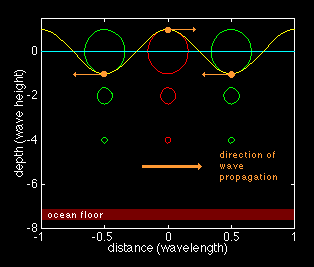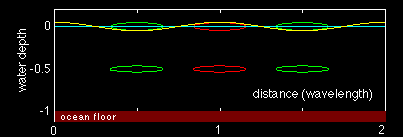Standing on a beach and watching the waves roll in and break, one might guess that water is moving bodily towards the shore. But no water is piling up on the beach. Watching a piece of floating debris beyond the breakers, we can see it move towards the shore on the crest of a wave, and move the same distance backward with the trough of the wave. The debris moves in a roughly circular path perpendicular to the water's surface. Water waves are surface waves, a mixture of longitudinal and transverse waves. Surface waves in oceanography are deformations of the sea surface. The deformations propagate with the wave speed, while the water molecules remain at the same positions on average. Energy, however, moves towards the shore. Most ocean waves are produced by wind, and the energy from the wind offshore is carried by the waves towards the shore.
We distinguish between deep-water waves and shallow-water waves. The distinction between deep and shallow water waves has nothing to do with absolute water depth. It is determined by the ratio of the water's depth to the wavelength of the wave.
The water molecules of a deep-water wave move in a circular orbit. The diameter of the orbit decreases with the distance from the surface. The motion is felt down to a distance of approximately one wavelength, where the wave's energy becomes negligible.

Link: Waves on surface of water (Youtube)
The orbits of the molecules of shallow-water waves are more elliptical.

The change from deep to shallow water waves occurs when the depth of the water, d, becomes less than one half of the wavelength of the wave, λ. When d is much greater than λ/2 we have a deep-water wave or a short wave. When d is much less than λ/2 we have a shallow-water wave or a long wave.
The speed of deep-water waves depends on the wavelength of the waves. We say that deep-water waves show dispersion. A wave with a longer wavelength travels at higher speed. In contrast, shallow-water waves show no dispersion. Their speed is independent of their wavelength. It depends, however, on the depth of the water.
Shallow-water waves move at a speed that is equal to the square root of the product of the acceleration of gravity and the water depth
Deep-water waves in the ocean are wind-generated waves. They can be generated by the local winds (sea) or by distant winds (swell).
Ocean waves are produce by a variety of forces. Meteorological forces (wind, air pressure) produce seas and swells. Astronomical forces produce the tides. Earthquakes produce tsunamis. Tides and tsunamis are shallow-water waves, even in the deep ocean. The deep ocean is shallow with respect to a wave with a wavelength longer than twice the ocean's depth.
A tsunami, also called seismic sea wave or tidal wave, is a catastrophic ocean wave, usually caused by a submarine earthquake occurring less than 50 km (30 miles) beneath the seafloor, with a magnitude greater than 6.5 on the Richter scale. Underwater or coastal landslides or volcanic eruptions also may cause a tsunami. The term tidal wave is more frequently used for such a wave, but it is a misnomer, for the wave has no connection with the tides. A tsunami can have a wavelength in excess of 100 km and period on the order of one hour. Because it has such a long wavelength, a tsunami is a shallow-water wave. Shallow-water waves move with a speed equal to the square root of the product of the acceleration of gravity and the water depth.
In the Pacific Ocean the typical water depth is about 4000 m. What is
the speed of a tsunami with a wavelength of 50 km.
Solution:
The rate at which a wave loses its energy is inversely related to its wavelength. A tsunami not only propagates with a high speed, it also can travel a great, transoceanic distance with only limited energy loss.
In the deep ocean, the amplitude of a tsunami is only a few feet. It cannot be felt aboard a ship or seen from the air in the open ocean. When the tsunami approaches the coastline, its speed decreases and its amplitude increases. (The power is proportional to the square of the amplitude times the speed. As the speed decreases, the amplitude increases.) The amplitude can grow to a height exceeding 100 feet. The tsunami can strike with devastating force.

Earthquakes generate tsunamis when the sea floor abruptly deforms and displaces the water above from its equilibrium position. Waves are formed as the displaced water under the influence of gravity attempts to regain its equilibrium. The initial size of a tsunami is determined by the amount of vertical sea floor deformation.
The earth and the moon orbit each other. They revolve about their common center of mass. Gravity provides the centripetal acceleration. The moon is constantly falling towards the earth and the earth is constantly falling towards the moon. But while each body moves on a curved trajectory, the distance between it and the other body stays constant.
The gravitational force between two objects is inverse proportional to the square of their distance. The distance between the earth and the moon is usually taken to be the distance between their centers. But the earth is an extended object. The gravitational acceleration due to the moon is larger than average on the side facing the moon, and smaller than average on the side facing away from the moon. Any loose material on the side of the earth facing the moon would accelerate at a higher than average rate towards the moon and move in a tighter orbit if not bound to the earth by gravity. Any loose material on the side of the earth facing away from the moon would accelerate at a lower than average rate towards the moon and move in a wider orbit if not bound to the earth by gravity. The waters of the oceans try to fall into these natural orbits, but the earth's gravity pulls them back. Water on the side of the earth facing the moon therefore forms a bulge outward from the center of the earth and toward the moon. Water on the side of the earth facing away from the moon forms a bulge outward from the center of the earth and away from the moon.
There are thus two separate tidal bulges in the earth's oceans, one on the side nearest the moon and one on the side farthest from the moon. The earth rotates once a day, so these bulges move across the earth's surface. There are two bulges, so each shore passes through two bulges a day. At those times, the tide is high. During the times when the seashore is between bulges, the tide is low. Because the moon moves along its orbit as the earth turns, the time interval between high tides is about 12 hours and 26 minutes, not exactly 12 hours. Since local water must flow to form the bulges as the earth rotates, there are cases where the tides are delayed as the water struggles to move through a channel. However, even in those cases, the high tides occur every 12 hours and 26 minutes.
Links: Tides
The sun's gravity also contributes to the tides, but its effects are smaller and serve mostly to vary the heights of high and low tide.